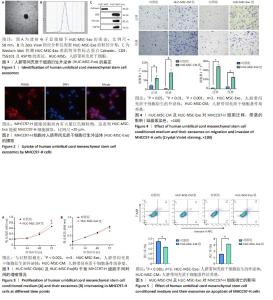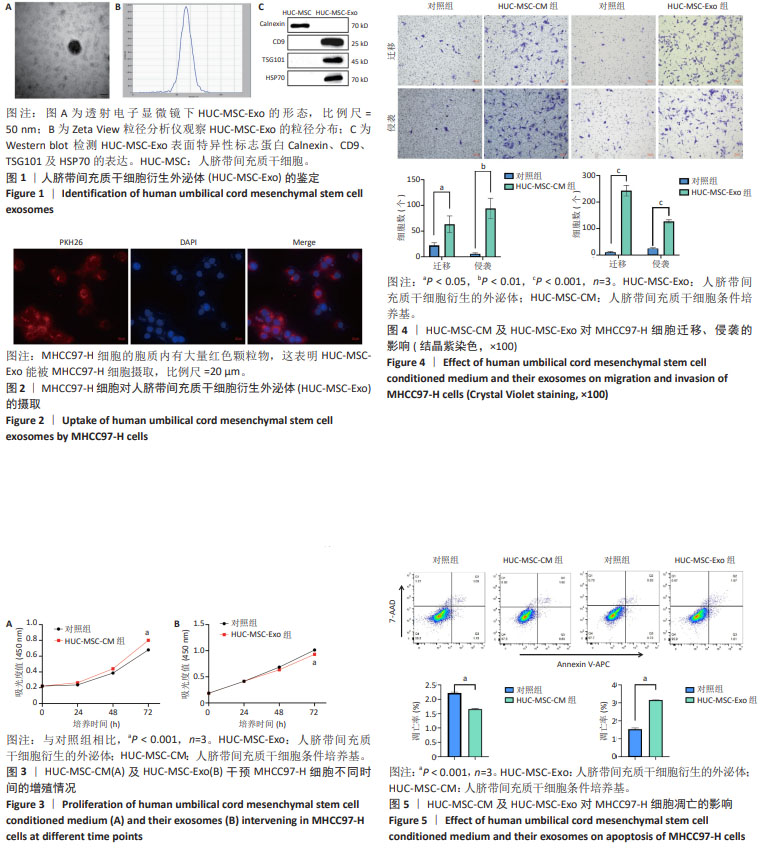[1] SUNG H, FERLAY J, SIEGEL RL, et al. Global Cancer Statistics 2020: GLOBOCAN Estimates of Incidence and Mortality Worldwide for 36 Cancers in 185 Countries. CA Cancer J Clin. 2021;71(3):209-249.
[2] RUMGAY H, ARNOLD M, FERLAY J, et al. Global burden of primary liver cancer in 2020 and predictions to 2040. J Hepatol. 2022;77(6):1598-1606.
[3] FORNER A, REIG M, BRUIX J. Hepatocellular carcinoma. Lancet. 2018; 391(10127):1301-1314.
[4] COFFIN P, HE A. Hepatocellular Carcinoma: Past and Present Challenges and Progress in Molecular Classification and Precision Oncology. Int J Mol Sci. 2023;24(17):13274.
[5] SUN H, YANG H, MAO Y. Personalized treatment for hepatocellular carcinoma in the era of targeted medicine and bioengineering. Front Pharmacol. 2023;14:1150151.
[6] DE BECKER A, RIET IV. Homing and migration of mesenchymal stromal cells: How to improve the efficacy of cell therapy? World J Stem Cells. 2016;8(3):73-87.
[7] LAN T, LUO M, WEI X. Mesenchymal stem/stromal cells in cancer therapy. J Hematol Oncol. 2021;14(1):195.
[8] LIANG W, CHEN X, ZHANG S, et al. Mesenchymal stem cells as a double-edged sword in tumor growth: focusing on MSC-derived cytokines. Cell Mol Biol Lett. 2021;26(1):3.
[9] SOUSA A, COELHO P, LEITE F, et al. Impact of umbilical cord mesenchymal stromal/stem cell secretome and cord blood serum in prostate cancer progression. Hum Cell. 2023;36(3):1160-1172.
[10] SHARAF K, EGGERSMANN TK, HAIDER SP, et al. Human Adipose-Derived Stem/Stromal Cells Promote Proliferation and Migration in Head and Neck Cancer Cells. Cancers (Basel). 2021;13(11):2751.
[11] ZHANG T, LIN R, WU H, et al. Mesenchymal stem cells: A living carrier for active tumor-targeted delivery. Adv Drug Deliv Rev. 2022;185:114300.
[12] TAKAYAMA Y, KUSAMORI K, TSUKIMORI C, et al. Anticancer drug-loaded mesenchymal stem cells for targeted cancer therapy. J Control Release. 2021;329:1090-1101.
[13] WU Y, SHUM HCE, WU K, et al. From Interaction to Intervention: How Mesenchymal Stem Cells Affect and Target Triple-Negative Breast Cancer. Biomedicines. 2023;11(4):1182.
[14] KALLURI R, LEBLEU VS. The biology, function, and biomedical applications of exosomes. Science. 2020;367(6478):eaau6977.
[15] PEGTEL DM, GOULD SJ. Exosomes. Annu Rev Biochem. 2019;88:487-514.
[16] VAKHSHITEH F, ATYABI F, OSTAD SN. Mesenchymal stem cell exosomes: a two-edged sword in cancer therapy. Int J Nanomedicine. 2019;14:2847-2859.
[17] WENG Z, ZHANG B, WU C, et al. Therapeutic roles of mesenchymal stem cell-derived extracellular vesicles in cancer. J Hematol Oncol. 2021; 14(1):136.
[18] ROSOCHOWICZ MA, LACH MS, RICHTER M, et al. Conditioned Medium - Is it an Undervalued Lab Waste with the Potential for Osteoarthritis Management? Stem Cell Rev Rep. 2023;19(5):1185-1213.
[19] KHATRI R, PETRY SF, LINN T. Intrapancreatic MSC transplantation facilitates pancreatic islet regeneration. Stem Cell Res Ther. 2021;12(1):121.
[20] CASARI G, DALL’ORA M, MELANDRI A, et al. Impact of soluble tumor necrosis factor-related apoptosis-inducing ligand released by engineered adipose mesenchymal stromal cells on white blood cells. Cytotherapy. 2023;25(6):605-614.
[21] HENDIJANI F. Explant culture: An advantageous method for isolation of mesenchymal stem cells from human tissues. Cell Prolif. 2017;50(2):e12334.
[22] MUSHAHARY D, SPITTLER A, KASPER C, et al. Isolation, cultivation, and characterization of human mesenchymal stem cells. Cytometry A. 2018; 93(1):19-31.
[23] YIN Z, JIANG K, LI R, et al. Multipotent mesenchymal stromal cells play critical roles in hepatocellular carcinoma initiation, progression and therapy. Mol Cancer. 2018;17(1):178.
[24] ZHANG X, LI N, ZHU Y, et al. The role of mesenchymal stem cells in the occurrence, development, and therapy of hepatocellular carcinoma. Cancer Med. 2022;11(4):931-943.
[25] LOTFY A, ABOQUELLA NM, WANG H. Mesenchymal stromal/stem cell (MSC)-derived exosomes in clinical trials. Stem Cell Res Ther. 2023;14(1):66.
[26] CHEN J, JI T, WU D, et al. Human mesenchymal stem cells promote tumor growth via MAPK pathway and metastasis by epithelial mesenchymal transition and integrin α5 in hepatocellular carcinoma. Cell Death Dis. 2019;10(6):425.
[27] LIU C, LIU Y, XU XX, et al. Mesenchymal stem cells enhance the metastasis of 3D-cultured hepatocellular carcinoma cells. BMC Cancer. 2016;16:566.
[28] GU JJ, HOJ J, ROUSE C, et al. Mesenchymal stem cells promote metastasis through activation of an ABL-MMP9 signaling axis in lung cancer cells. PLoS One. 2020;15(10):e0241423.
[29] YUAN Y, ZHOU C, CHEN X, et al. Suppression of tumor cell proliferation and migration by human umbilical cord mesenchymal stem cells: A possible role for apoptosis and Wnt signaling. Oncol Lett. 2018;15(6):8536-8544.
[30] GU H, JI R, ZHANG X, et al. Exosomes derived from human mesenchymal stem cells promote gastric cancer cell growth and migration via the activation of the Akt pathway. Mol Med Rep. 2016;14(4):3452-3458.
[31] YAO X, MAO Y, WU D, et al. Exosomal circ_0030167 derived from BM-MSCs inhibits the invasion, migration, proliferation and stemness of pancreatic cancer cells by sponging miR-338-5p and targeting the Wif1/Wnt8/β-catenin axis. Cancer Lett. 2021;512:38-50.
[32] LI GC, YE QH, XUE YH, et al. Human mesenchymal stem cells inhibit metastasis of a hepatocellular carcinoma model using the MHCC97-H cell line. Cancer Sci. 2010;101(12):2546-2553.
[33] FURUSAKA Y, INOUE S, MIZOGUCHI I, et al. Potent antitumor effects of the conditioned medium of bone marrow-derived mesenchymal stem cells via IGFBP-4. Cancer Sci. 2023;114(6):2499-2514.
[34] LI T, ZHANG C, DING Y, et al. Umbilical cord-derived mesenchymal stem cells promote proliferation and migration in MCF-7 and MDA-MB-231 breast cancer cells through activation of the ERK pathway. Oncol Rep. 2015;34(3):1469-1477.
[35] MONDAL J, PILLARISETTI S, JUNNUTHULA V, et al. Hybrid exosomes, exosome-like nanovesicles and engineered exosomes for therapeutic applications. J Control Release. 2023;353:1127-1149.
[36] XU Y, LAI Y, CAO L, et al. Human umbilical cord mesenchymal stem cells-derived exosomal microRNA-451a represses epithelial-mesenchymal transition of hepatocellular carcinoma cells by inhibiting ADAM10. RNA Biol. 2021;18(10):1408-1423.
[37] XU Y, SHEN L, LI F, et al. microRNA-16-5p-containing exosomes derived from bone marrow-derived mesenchymal stem cells inhibit proliferation, migration, and invasion, while promoting apoptosis of colorectal cancer cells by downregulating ITGA2. J Cell Physiol. 2019;234(11):21380-21394.
[38] QI J, ZHANG R, WANG Y. Exosomal miR-21-5p derived from bone marrow mesenchymal stem cells promote osteosarcoma cell proliferation and invasion by targeting PIK3R1. J Cell Mol Med. 2021;25(23):11016-11030.
[39] YASSINE S, ALAAEDDINE N. Mesenchymal Stem Cell Exosomes and Cancer: Controversies and Prospects. Adv Biol (Weinh). 2022;6(2):e2101050. |

